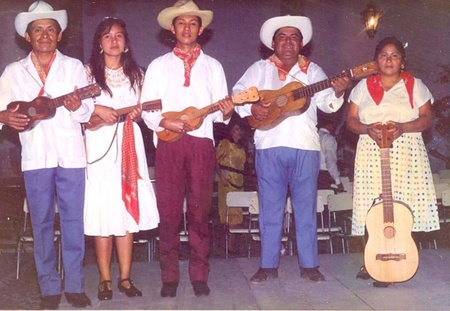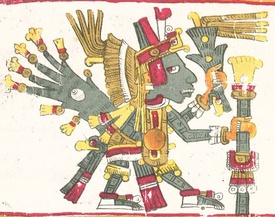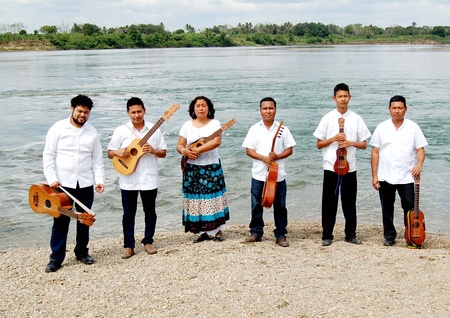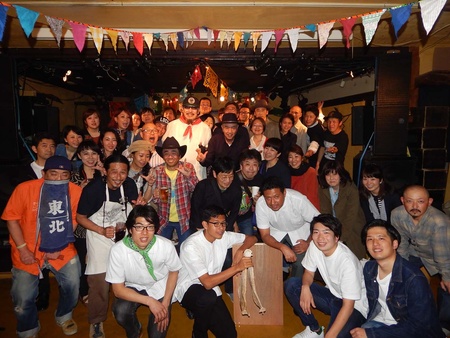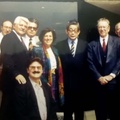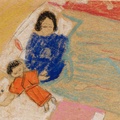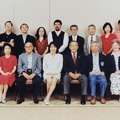Julio Mizzumi Guerrero Kojima is an acclaimed musician of the son jarocho and fandango movement. To achieve this recognition, this Nikkei musician, who plays the jarana (similar to a guitar), has traveled a long road to understanding that the music and traditions of his people are a part of his identity, an inner essence that gradually flourished and found expression. This process occurred while he was also searching for his Japanese roots and the legacy of Japanese immigrants in the Sotavento region of Veracruz.
Julio Mizzumi heard son jarocho, as the folk music unique to Veracruz is known, at festivals throughout his childhood in Otatitlán. However, it was while working as a preschool teacher in the town of Tlacotalpan that he began playing son jarocho on the jarana. The devotion, love and commitment of Julio and Belén, his partner in both music and life, to this music was sealed when the couple toured the towns in Los Tuxtlas region. In those communities, Belén and Julio learned traditional ways of interpreting and feeling the son jarocho, through endless fandangos, or days-long celebrations centered on playing and singing son jarocho.
Through his participation in those fandangos, Julio Mizzumi gradually discovered the roots that bound him to the deepest traditions of these towns. But at the same time, he understood that the representation of jarocha music in those communities was complicated, as few musicians from the older generations remained and the musical memory was facing, especially in his village of Otatitlán. Economic transformations, both national and global, weakened traditional communities, changing ways of life in the larger Sotavento region. The effects in small towns were reflected in the destruction of community ties and the natural environment, including the flora, fauna and the Papaloapan River (River of Butterflies); in other words, the deterioration of the entire microcosm in which the varied cultures of the Sotavento had flourished.
Aware of these changes, Julio and Belén, then teachers at the preschool in Otatitlán, formed a son jarocho band in 1997 and called it Yacatecuhtli (the Náhuatl word for “man with the nose”, the Aztec god of commerce). Forming the band was just the first step in a larger endeavor that opened up and expanded over time. Julio and Belén weren't satisfied with simply playing son jarocho music, much less in the stereotyped way that had come to dominate. They also understood that the group's efforts would be insufficient if the community of Otatitlán merely listened to their music, rather than feeling it and taking it on it as part of its own identity.
In the early yeras, the members of Yacatecuhtli worked hard to perfect their skills as musicians and to create closer ties to the community. As a group, they began to accompany the thousands of pilgrims who came from all over to Otatitlán to worship the image of the Black Christ, an effigy that has been venerated since the late 16th century. Each May the pilgrims, accompanied by jaranas and their music, visit the sanctuary to ask for favors and give thanks for the blessings they have received from the Black Christ throughout the year. The pilgrims also commemorate the the Black Christ's arrival on the River of the Butterflies more than 400 years ago, as the legend goes.
Throughout those years, Yacatecuhtli became an established folklore group, with the addition of two of Julio's brothers; Martín Yasuo and José Mitsumori; Julio’s son, also named Julio; as well as Noé Guerrero and Diego Almazán. With the group’s music fully developed, Yacatecuhtli began to work on a project that tied it directly to the community: First, it joined with other jarana and fandango groups to articulate a broader movement to ensure the preservation of the music. Second, in 2009 the band organized a series of workshops at the house of Julio's mother, Margarita Kojima, that were aimed at involving and directly serving the community of Otatitlán. This space and these activities came to be known as the Jardín Kojima (Kojima Garden).
The workshops for children and youth at Jardín Kojima were focused on teaching traditional tap dancing and son jarocho in ways enabled the children to be active participants in their own learning. At the time, they paid for the lessons by collecting plastic bottles in the streets and from homes in Otatitlán. The funds they raised from recycling the bottles paid for the workshops and at the same time involved children and their families in preserving and cleaning up the community. The campaign was so successful that it permeated the entire community, and today one rarely sees that kind of garbage in the streets of the town.
Jardín Kojima also began offering a workshop for those interested in learning how to make the jarana, which the participants then used to play son jarocho. Artisanal production of these instruments enabled the participants to learn about the use of cedar wood and the origins of son jarocho; that is, to understand music as an integral part of the environment that must be preserved in order to preserve the overall culture.
In relation to environmental protection, the Jardin's activities began focusing on conservation of the local flora and fauna. The flowers and other plants cultivated there are part of the work of raising awareness and educating the community. Environmental conservation, in that sense, is also related to preparation of regional dishes and the use of local ingredients, a task to which Margaret Kojima has shown great dedication. Doña Mago, as she is known, specializes in making the candies that are a culinary tradition of the village. Conservation of fauna is another activity at the Jardín, carried out through the rescue and reproduction of tortoises, which are later transferred to a large center devoted to conservation of the species in the state of Veracruz.
Music, tap dancing, environmental clean-up, preservation of the flora and fauna are all understood as essential elements of the culture of the Sotavento and the persistence of the Otatitlán community. The teaching at Jardín workshops is done in such a way that children, youth and their families become involved in volunteering, as active subjects rather than merely as objects or spectators who need to be “educated.” Social responsibility and commitment to the community have become the guiding principles of Jardín Kojima and Yacatecuhtli.
The tenacity of Yacatecuhtli and the son and fandango movement in Veracruz have vastly broadened knowledge about son jarocho, even in places as far away as Japan. A group of students from the University of Tokyo recently visited Otatitlán to learn about, enjoy, and contribute to raising the visibility of this musical genre from its roots. The Japanese students formed a group called Los Laguitos that has mastered son jarocho and regularly performs the music in their country. The group's name was chosen by these young people to symbolize the influence that Julio Mizzumi has had on the group's formation and on the dissemination of son jarocho in Japan, since in Japanese “Mizzumi” means “lake.”
Video of Los Laguitos visiting Jalcomulco, Veracruz
Julio Mizzumi and his son visited Japan in 2017, with the goal of performing son jarocho in the birthplace of Julio’s great-grandfather. At the Komaba and Hongo campuses of the University of Tokyo and at the University of Rikkyo, Julio and his son held concerts and led workshops with Japanese students. This meeting sparked the interest of other young people in jarana music, prompting them to visit Veracruz to get to know the musicians and the places where the music originated.
For Julio Mizzumi, his siblings and his children, these exchanges and visits by Japanese musicians represent a new way of relating to their origins and the legacy of immigrants who settled in Veracruz in the early 20th century. The graves of those immigrants can be found in villages throughout the region and the histories they have handed down are still present through the work of Jardín Kojima. The traces that history has left on the identity of the community of Otatitlán are the footprints of migrations and cultures that are often difficult to distinguish. The musical evenings spent in the gardens at Margaret Kojima's house, as well as at the universities of Tokyo and Rikkyo, demonstrate that the fandango is alive and well and capable of bringing together cultures that are not as different as one might think.
© 2019 Sergio Hernández Galindo


